Podcast
Questions and Answers
Which of the following correctly describes the trend of atomic radius across a period?
Which of the following correctly describes the trend of atomic radius across a period?
- The atomic radius generally increases due to decreasing nuclear charge.
- The atomic radius fluctuates without a clear pattern due to variations in electron configuration.
- The atomic radius generally decreases due to an increase in nuclear charge. (correct)
- The atomic radius remains constant because of consistent electron shielding.
What is the primary factor that causes the increase in atomic radius as you move down a group?
What is the primary factor that causes the increase in atomic radius as you move down a group?
- Decrease in the effective nuclear charge, allowing the atoms to expand
- Addition of new electron shells, significantly increasing the volume (correct)
- Increased nuclear charge pulling electrons outwards
- Gain of protons in the nucleus causing expansion
How does ionization energy generally change across a period, and what is the main cause for this change?
How does ionization energy generally change across a period, and what is the main cause for this change?
- It fluctuates unpredictably because of electron interactions.
- It increases because of the increased nuclear charge, making it more difficult to remove electrons. (correct)
- It remains constant as electron shielding balances nuclear charge.
- It decreases due to smaller nuclear charge attracting electrons more weakly.
Which statement accurately describes how electronegativity changes as you move down a group?
Which statement accurately describes how electronegativity changes as you move down a group?
What is the main principle underlying the octet rule and what is an exception to this rule?
What is the main principle underlying the octet rule and what is an exception to this rule?
Who arranged the elements in order of increasing atomic mass and also predicted the existence of undiscovered elements?
Who arranged the elements in order of increasing atomic mass and also predicted the existence of undiscovered elements?
According to the periodic law, which of the following determines the periodic repetition of chemical and physical properties of elements?
According to the periodic law, which of the following determines the periodic repetition of chemical and physical properties of elements?
Which term describes the vertical columns in the periodic table?
Which term describes the vertical columns in the periodic table?
Which of the following groups of elements are known for being highly reactive?
Which of the following groups of elements are known for being highly reactive?
Which category of elements typically have properties of both metals and nonmetals?
Which category of elements typically have properties of both metals and nonmetals?
Which of the following is a characteristic of nonmetals?
Which of the following is a characteristic of nonmetals?
Which group of elements is known for being extremely unreactive?
Which group of elements is known for being extremely unreactive?
Which block of elements contains only partially or completely filled s orbitals?
Which block of elements contains only partially or completely filled s orbitals?
Flashcards
Periodic Law
Periodic Law
The periodic repetition of chemical and physical properties of elements when arranged by increasing atomic number.
Antoine Lavoisier
Antoine Lavoisier
Compiled a list of the first known elements.
John Newlands
John Newlands
Arranged elements by increasing atomic mass and created the law of octaves.
Dimitri Mendeleev
Dimitri Mendeleev
Signup and view all the flashcards
Henry Moseley
Henry Moseley
Signup and view all the flashcards
Metalloids
Metalloids
Signup and view all the flashcards
Alkaline Metals
Alkaline Metals
Signup and view all the flashcards
Noble Gases
Noble Gases
Signup and view all the flashcards
p block elements
p block elements
Signup and view all the flashcards
Ionic radius trend
Ionic radius trend
Signup and view all the flashcards
Ionization energy trend
Ionization energy trend
Signup and view all the flashcards
Electronegativity trend
Electronegativity trend
Signup and view all the flashcards
Octet rule
Octet rule
Signup and view all the flashcards
Study Notes
Scientists and Periodic Table Development
- Antoine Lavoisier: Compiled a list of early known elements.
- John Newlands: Arranged elements by increasing atomic mass, noticing a pattern every eighth element (law of octaves).
- Dimitri Mendeleev: Showed a link between atomic mass and element properties, arranged elements by increasing atomic mass, and predicted undiscovered elements.
- Henry Moseley: Discovered atomic number (unique number of protons), arranged elements by increasing atomic number creating a periodic pattern of properties.
- Periodic Law: States that elements' chemical and physical properties repeat periodically when arranged by increasing atomic number.
Modern Periodic Table Structure
- Groups: Vertical columns in the periodic table.
- Periods: Horizontal rows in the periodic table.
- Representative Elements: Groups 1, 2, and 13-18.
- Transition Elements: Groups 3-12.
- Metal Classification:
- Metals: Shiny, solid at room temperature, good conductors of heat and electricity.
- Alkaline Metals (Group 1): Most reactive elements (excluding hydrogen).
- Alkaline Earth Metals (Group 2): Highly reactive.
- Transition Metals (Groups 3-12): Wide range of properties.
- Inner Transition Metals: Divided into Lanthanides and Actinides.
- Lanthanides: F block elements following Lanthanum.
- Actinides: F block elements following Actinium.
- Metalloids: Exhibit properties of metals and nonmetals.
- Nonmetals: Generally gases or brittle solids, poor conductors of heat and electricity. Bromine is the only liquid nonmetal.
- Halogens (Group 17): Highly reactive elements often in compounds.
- Noble Gases (Group 18): Unreactive, used in applications requiring inertness such as lasers, light bulbs, and neon signs.
Valence Electrons and Electron Configurations
- Valence Electrons: Electrons in the outermost energy level (determine chemical properties).
- Period: Horizontal rows in the periodic table.
- Representative Elements: Groups 1, 2, and 13-18 (s and p block elements).
- s Block Elements: Groups 1, 2, and Helium (partially or completely filled s orbitals).
- p Block Elements: Groups 13-18 (partially or completely filled p orbitals).
- d Block Elements: Groups 3-12 (partially filled d orbitals).
- f Block Elements: Inner transition elements (partially filled 4f or 5f orbitals).
Periodic Trends
- Atomic Radius:
- Period Trend: Decreases across a period due to increasing nuclear charge.
- Group Trend: Increases down a group due to added electron shells.
- Ionic Radius:
- Period Trend: Decreases across a period for cations, also for anions.
- Group Trend: Increases down a group due to added electron shells.
- Ionization Energy:
- Period Trend: Increases across a period due to increasing nuclear charge.
- Group Trend: Decreases down a group due to increasing distance from the nucleus.
- Electronegativity:
- Period Trend: Increases across a period due to increasing nuclear charge.
- Group Trend: Decreases down a group due to increasing distance from the nucleus.
- Octet Rule: Atoms tend to gain, lose, or share electrons to achieve 8 valence electrons (except for the first period with a duet).
Studying That Suits You
Use AI to generate personalized quizzes and flashcards to suit your learning preferences.




